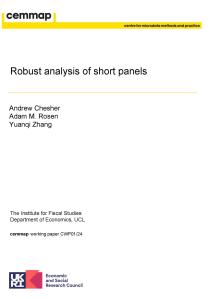We need to talk about local government funding. Despite concerns about the quality of local services and the financial health of councils, local government funding has been conspicuously absent from the election debate. And the spending plans pencilled in for after the election imply another round of cuts to government funding for councils could be on its way.
In this context, a new election report from researchers at the Institute for Fiscal Studies, funded by the abrdn Financial Fairness Trust and the Nuffield Foundation, looks at how English councils’ finances have evolved since the last election in 2019 and since 2010. It finds that
- English councils’ core funding from central government and local taxes (such as council tax and business rates) this financial year, 2024–25, is set to be 9% lower in real terms than in 2010–11 – equivalent to a cut of 18% per resident, given substantial population growth. A 14% (10% per resident) rise in funding over the last parliament (much of it for social care) has not been enough to offset the much larger 21% cut (26% per resident) made during the 2010s.
- Councils are much more reliant on raising their own revenues through local taxation than 14 years ago: council tax will contribute 53% of core funding this year, up from 36% in 2010–11.
- Despite an overall fall in per-person spending on local service provision of 9%, spending on adult and acute children’s social care has risen by 17% per person. Together, these made up 65% of council budgets in 2023–24, up from 63% in 2019–20 and 50% in 2010–11.
- This is squeezing out other areas of spending: since 2010–11, spending on housing is down by a third, spending on highways and transport, culture and leisure, and planning are down by more than 40%, and spending on youth services and Sure Start down by 70%.
Other key findings of the report include:
On the distribution of council funding
- Compared with 2010–11, funding per person this year is set to be 26% lower in the tenth of areas with the highest deprivation, compared with ‘just’ 11% lower in the least deprived areas.
- This reflects cuts during the 2010s that hit poorer areas harder than richer areas – by design. During this parliament, the tenth of councils with the highest levels of deprivation have seen their core funding per person increase by 14% in real terms, compared with 5% for the least deprived areas. But these changes since 2019–20 have not been enough to fully undo bigger cuts to funding in poorer areas seen in the 2010s.
On financial pressures
- Despite real-terms increases in funding since 2019–20, an increasing number of councils are facing major financial difficulties: 6 have made emergency changes to their budgets after issuing a so-called Section 114 notice, 29 have had to get special permission to use investment funding for day-to-day expenses, and budget overspends have ballooned. A range of specific local circumstances are often involved but growing demands and increases in costs that have outpaced general inflation will not have helped.
- The number of children in secure units and children’s homes and the number with Education, Health and Care plans increased by over 30% between early 2020 and early 2023, while the number of homeless families in B&Bs doubled between the end of 2019 and September 2023.
- The cost per placement in children’s homes increased by 20% between 2019–20 and 2022–23, and the cost of care home placements for adults aged 65 or over increased by 35% between 2019–20 and 2023–24 – both almost double whole-economy inflation measured over the same periods.
- To help pay for these rising demands and costs, councils budgeted to draw down £1.2 billion in reserves last year, after drawing down £1.7 billion in 2022–23. This follows two years during which councils were able to pay a total of £7–8 billion into reserves, as the funding they received to address the COVID-19 pandemic in most cases substantially exceeded the short-term financial hit of the pandemic. But reserves can only be spent once, so councils still face the difficult task of bringing spending and funding back into balance.
Kate Ogden, a senior research economist at IFS and an author of the report, said:
‘A big increase in funding from central government targeted at social care services means that English councils’ funding this year is set to be notably higher in real terms than at the time of the last general election in 2019–20, at least adjusting for whole-economy inflation. This is a big change from the three parliaments during the 2010s, when large cuts to funding from central government saw overall core funding fall by 26% per person. However, like most public services that saw their budgets squeezed in the 2010s, the more recent increases in funding have not undone these previous cuts. Councils are still very much feeling the financial effects of the late 2000s Global Financial Crisis – 15 years later.’
David Phillips, an associate director at IFS and another author of the report, said:
‘Councils have faced surging demand for special educational needs support, specialist children’s social care placements, adult social care, and temporary accommodation for the homeless. At the same time, rates of inflation for key services have far outpaced economy-wide inflation. Given funding is still much lower than in 2010, this has meant local councils have dramatically reduced their spending on things like leisure and culture, planning and development, transport and youth services and have devoted more and more of their budgets to these statutory duties towards a relatively small number of very needy and vulnerable residents. Some councils have already been pushed to the financial brink – and more are likely to follow unless demand and cost pressures abate. Given the fundamental role of local government in delivering services, and indeed in our democracy, we have heard remarkably little about council funding in the election campaign. It will certainly be a key issue post-election.’
Mark Franks, Director of Welfare at the Nuffield Foundation, said:
‘A combination of funding cuts in the 2010s and rising demand for statutory services has led to inevitable spending reductions in areas such as leisure and culture, planning and development, transport and youth services. These services play an important role in supporting individual and community well-being, in both the shorter and longer term, and they cannot be squeezed indefinitely. The next government will face a difficult but important challenge in ensuring that local government finances are put on a sustainable footing and that the trade-offs involved are considered and addressed in a strategic and transparent manner.’









